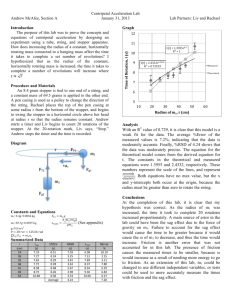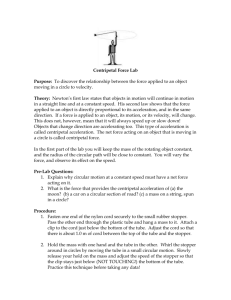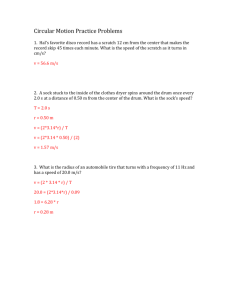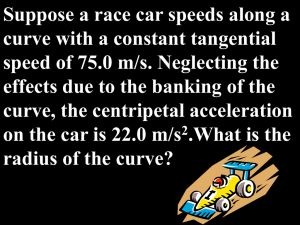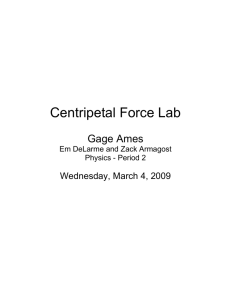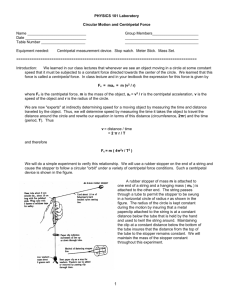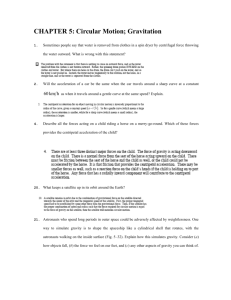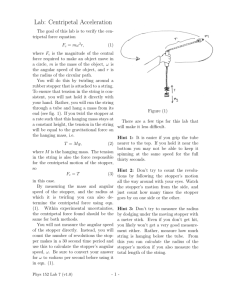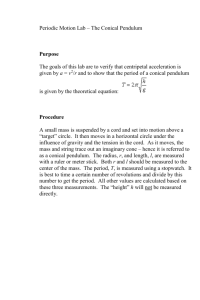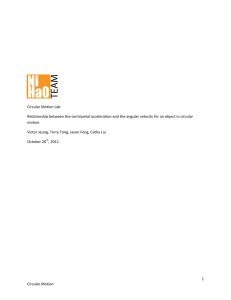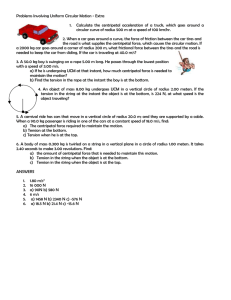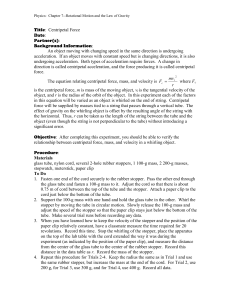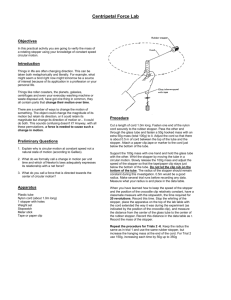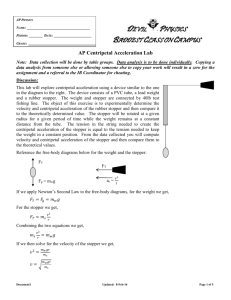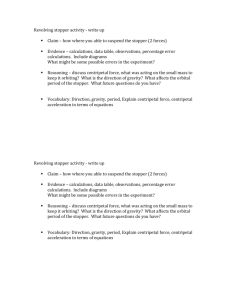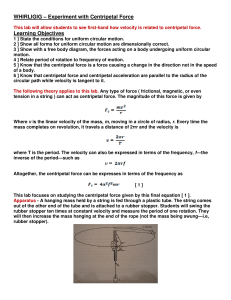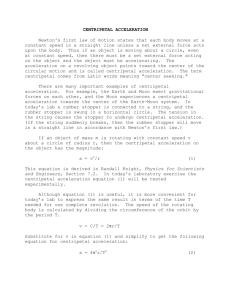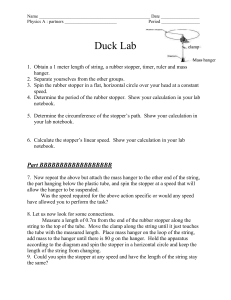Uniform Circular Motion Lab - final
advertisement
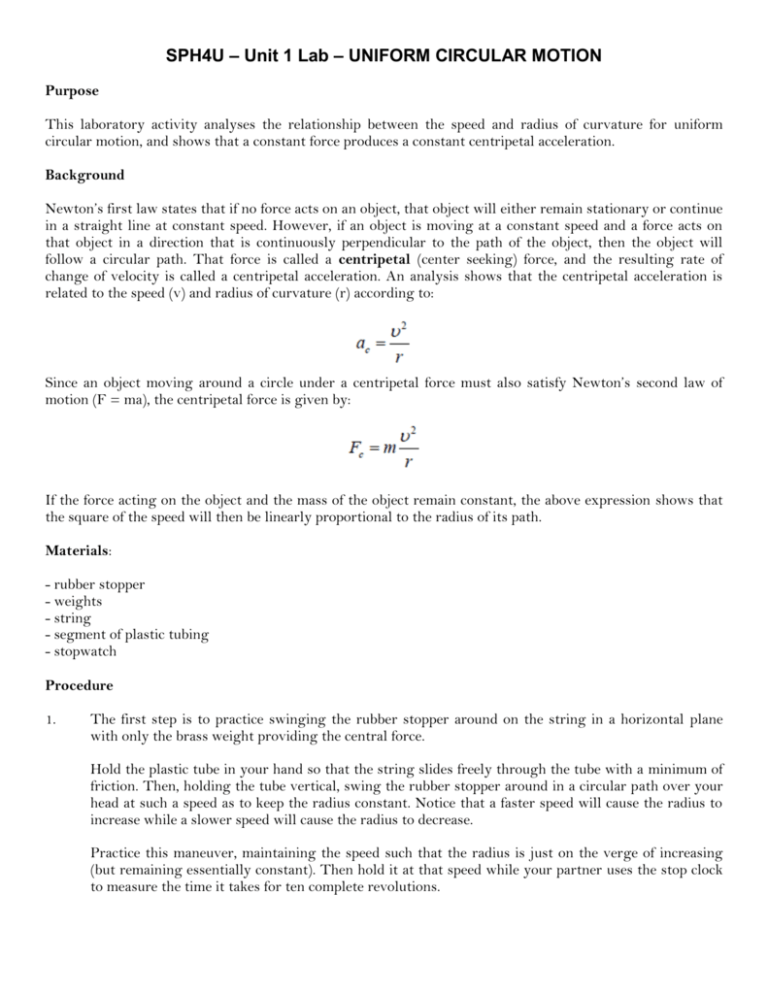
SPH4U – Unit 1 Lab – UNIFORM CIRCULAR MOTION Purpose This laboratory activity analyses the relationship between the speed and radius of curvature for uniform circular motion, and shows that a constant force produces a constant centripetal acceleration. Background Newton’s first law states that if no force acts on an object, that object will either remain stationary or continue in a straight line at constant speed. However, if an object is moving at a constant speed and a force acts on that object in a direction that is continuously perpendicular to the path of the object, then the object will follow a circular path. That force is called a centripetal (center seeking) force, and the resulting rate of change of velocity is called a centripetal acceleration. An analysis shows that the centripetal acceleration is related to the speed (v) and radius of curvature (r) according to: Since an object moving around a circle under a centripetal force must also satisfy Newton’s second law of motion (F = ma), the centripetal force is given by: If the force acting on the object and the mass of the object remain constant, the above expression shows that the square of the speed will then be linearly proportional to the radius of its path. Materials: - rubber stopper - weights - string - segment of plastic tubing - stopwatch Procedure 1. The first step is to practice swinging the rubber stopper around on the string in a horizontal plane with only the brass weight providing the central force. Hold the plastic tube in your hand so that the string slides freely through the tube with a minimum of friction. Then, holding the tube vertical, swing the rubber stopper around in a circular path over your head at such a speed as to keep the radius constant. Notice that a faster speed will cause the radius to increase while a slower speed will cause the radius to decrease. Practice this maneuver, maintaining the speed such that the radius is just on the verge of increasing (but remaining essentially constant). Then hold it at that speed while your partner uses the stop clock to measure the time it takes for ten complete revolutions. 2. At high speeds the string between the rubber stopper and the plastic holder tends to be almost parallel with the floor, while at slower speeds the stopper tends to be pulled down by as much as several degrees. You are to ignore this fact and consider the radius of the circle to be the distance from the holder to the center of the rubber stopper. In order to keep the radius at a known value while swinging the stopper around at constant speed, attach a small piece of tape to the string near the bottom of the plastic holder. The radius can then be held constant by observing the position of the tape relative to the holder. BE SURE THAT THE TAPE DOES NOT STOP THE STRING FROM SLIDING SMOOTHLY IN THE TUBE. You should now be ready to swing the rubber stopper at some radius and measure the time it takes for ten revolutions. Three separate measurements of time will be taken (for each radius used) and averaged for best results. This part of your data table may look like the following: 3. Select at least six values for the radius between 25 cm and 75 cm and for each radius, take three measurements of the time interval for ten complete rotations. 4. Measure the mass of the rubber stopper in kilograms and the weight of the brass weight in newtons. Analysis 1. Use appropriate formulas to find the: a) distance traveled in ten circumferences. b) average time to travel the distance (d). c) speed and square of the speed. 2. Construct a graph of the square of the speed as a function of the radius. Determine the value of the centripetal acceleration from the graph. (Include correct units) 3. Comparison: Hypothetically, the centripetal acceleration was the same for each of your data points. That' s because a larger radius permits a greater speed for the same available acceleration. (That's why car drivers can go faster when the turns are gradual.) The acceleration you determined from the graph represents an average value for accelerations that would theoretically all be the same. Use your average acceleration and the mass of the stopper to figure the force needed to cause the centripetal acceleration. Compare that force with the weight of the brass hanging object. Express your comparison as a percent difference.
